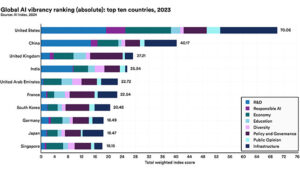MIT Report: Most Organizations See No Enterprise Return on Gen AI Investments
A latest report out of the MIT Media Lab discovered that regardless of $30-40 billion in enterprise spending on generative AI, 95% of organizations are seeing no enterprise return.
The authors of the July 2025 report, titled “The GenAI Divide: State of AI in Enterprise 2025,” wrote: “The outcomes are so starkly divided throughout each patrons (enterprises, mid-market, SMBs) and builders (startups, distributors, consultancies) that we name it the Gen AI Divide,” noting that “Simply 5% of built-in AI pilots are extracting hundreds of thousands in worth, whereas the overwhelming majority stay caught with no measurable P&L impression.”
What the ‘Gen AI Divide’ Means
The divide is outlined by excessive adoption however low transformation. The report stated solely two industries present clear indicators of structural disruption, whereas seven others present “widespread experimentation with out transformation.
It backed this with an AI Market Disruption Index and included an interview quote from a mid-market manufacturing COO: “The hype on LinkedIn says the whole lot has modified, however in our operations, nothing elementary has shifted. We’re processing some contracts sooner, however that is all that has modified.”
Pilot-to-Manufacturing: The place Most Efforts Stall
The sharpest proof of the divide is deployment: “solely 5% of customized enterprise AI instruments attain manufacturing.” The report characterised this as a 95% failure price for enterprise AI options and attributes it to brittle workflows, weak contextual studying, and misalignment with day-to-day operations. It additionally recorded person skepticism about vendor choices: “We have seen dozens of demos this 12 months. Possibly one or two are genuinely helpful. The remaining are wrappers or science initiatives.”
Enterprises run essentially the most pilots however convert the fewest; mid-market organizations transfer sooner from pilot to full implementation (~90 days) than giant enterprises (9 months or longer).
Adoption Numbers vs. Enterprise Affect
Common-purpose instruments are broadly explored, however impression is proscribed: “Over 80% of organizations have explored or piloted [ChatGPT/Copilot], and practically 40% report deployment,” but these primarily enhance particular person productiveness, not P&L efficiency. In the meantime, 60% of organizations evaluated enterprise-grade programs, “however solely 20% reached pilot stage and simply 5% reached manufacturing.”
The Root Trigger: The Studying Hole
The report’s central clarification is that the core barrier is studying slightly than infrastructure, regulation, or expertise: “Most GenAI programs don’t retain suggestions, adapt to context, or enhance over time.”
Customers usually favor client LLM interfaces for drafts, however reject them for mission-critical work because of lack of reminiscence and persistence. One interviewee defined: “It is glorious for brainstorming and first drafts, nevertheless it does not retain information of consumer preferences or be taught from earlier edits. It repeats the identical errors and requires in depth context enter for every session. For top-stakes work, I would like a system that accumulates information and improves over time.”
The report summarized this hole succinctly: “ChatGPT’s very limitations reveal the core concern behind the Gen AI Divide: it forgets context, does not be taught, and may’t evolve.” For advanced, longer-running duties, people stay the robust desire.
Shadow AI: Staff Cross the Divide Informally
Whereas official applications lag, a “shadow AI economic system” has emerged: “solely 40% of corporations say they bought an official LLM subscription,” but staff from over 90% of the businesses reported common use of non-public AI instruments for work. This sample reveals people can cross the divide with versatile instruments even when enterprise initiatives stall.
Why This Issues
For groups tasked with operationalizing AI in cloud environments, the report indicated that the bottleneck lies in programs that may be taught, keep in mind, and combine with workflow programs. The “divide” isn’t about mannequin IQ or uncooked infrastructure capability, however about embedding adaptive habits into the appliance layer and course of orchestration.
Methodology
The report relies on a multi-method analysis design performed between January and June 2025. Researchers carried out a scientific overview of greater than 300 publicly disclosed AI initiatives, held 52 structured interviews with representatives from organizations throughout industries, and gathered 153 survey responses from senior leaders at 4 main conferences. Firm-specific information and quotations had been anonymized to adjust to disclosure insurance policies.
The report is accessible on the nandapapers GitHub repo here.
In regards to the Creator
David Ramel is an editor and author at Converge 360.





